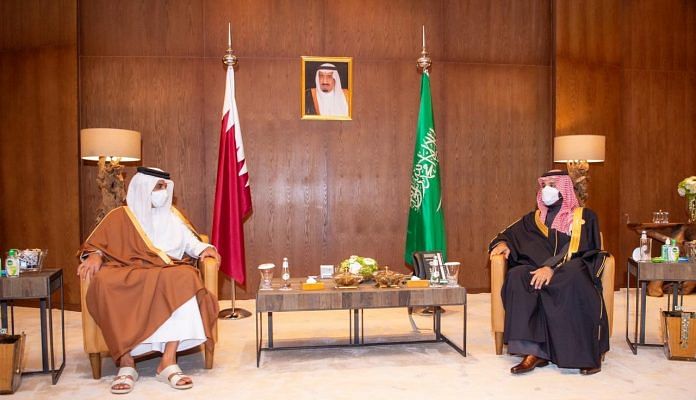Saudi Arabia and three other Arab states agreed to fully restore ties with neighboring Qatar on Tuesday after a sustained U.S. push for the countries to unite against Iran.
The breakthrough in ending a dispute that erupted in 2017 came just two weeks before President-elect Joe Biden takes office after pledging a new start with Tehran.
Saudi Arabia, Bahrain, the United Arab Emirates and Egypt signed an accord with Qatar in a mirrored concert hall in the northwestern Saudi town of Al Ula during a summit of Gulf Cooperation Council leaders, bringing the regional split to an end — at least on paper.
The states were able to find a “resolution to all areas of difference,” and agreed to a “restoration of all diplomatic ties,” Saudi Foreign Minister Prince Faisal bin Farhan told reporters on Tuesday. “It will be a strong and important foundation to the future of the region and its stability.”
The reconciliation takes on greater significance given the impending changing of the guard in Washington. While President Donald Trump led an offensive to weaken Iran through sanctions, Biden has pledged to engage diplomatically with the Islamic Republic if it first returns to the terms of the 2015 nuclear deal.
Saudi Crown Prince Mohammed bin Salman said Gulf leaders needed to “unify our efforts to advance our region, and face the challenges that surround us — especially the challenges represented by Iran’s nuclear and ballistic missiles programs.”
Warm embrace
Qatar’s ruler Emir Sheikh Tamim bin Hamad Al Thani landed in Saudi Arabia to a warm embrace from Prince Mohammed, the kingdom’s de facto ruler, his first visit since the 2017 falling out that cut trade, travel and diplomatic ties.
Saudi Arabia reopened its airspace and land and sea borders to Qatar on Monday, a key breakthrough. Qatar — the world’s largest exporter of liquefied natural gas — is a small peninsula whose only land border is with Saudi Arabia.
Prince Mohammed met Sheikh Tamim at the airport in Al Ula, where the two men — both wearing masks — hugged. It was the only physical contact as other leaders maintained social distance.
UAE Minister of State for Foreign Affairs Anwar Gargash wrote on Twitter that a “shining new page” was beginning, and Prince Mohammed said “courageous steps” had been taken.
The accord was a major step, but it’s unclear how far the reconciliation will go or how long it will last. While the six-member GCC had seen earlier disputes over four decades, the 2017 split cut deepest. The four boycotting nations accused Doha of meddling in their internal affairs, supporting hardline Islamist groups and building ties with Iran. Qatar denied the charges.
“The Gulf summit will formally end the Gulf rift and usher in some form of soft détente,” said Ayham Kamel, head of Middle East and North Africa at the Eurasia Group consultancy. “However, the fundamental issues that led initially to the dispute were only partially resolved, and the trust deficit between the Gulf leaders will not be healed immediately.”
Iran fears
Jared Kushner, U.S. President Donald Trump’s son-in-law and senior adviser, traveled to Saudi Arabia to witness the signing.
Qatar had increasingly turned to Iran and Turkey — another regional rival of Saudi Arabia and the UAE — for support, relying on Iranian airspace for overflights. That troubled Saudi Arabia and the Trump administration, which had initially backed the boycott, as it sought to expand its offensive to weaken Iran.
Asked whether the incoming U.S. government would be capable of containing Iran, Prince Faisal, the Saudi foreign minister, said all American administrations “are aware of Iran’s threats, even when they sometimes deal with it differently.”
“What we hear from Biden administration is that they are aware that Iran poses a threat to the region,” he said. “This gives us reassurance that they are serious in facing these threats, and of course there will be coordination and consultation between us.”
The wider economic and financial implications of resolving the dispute will be felt particularly in Qatar. The country’s main equities benchmark rose the most in the Middle East on Tuesday.
It’s also good news for Qatar Airways, which had to abandon plans to add new routes and make lengthy diversions when barred from Saudi airspace.
Even so, economists say trade is unlikely to return to its former levels. In the year before the split, Qatar’s total trade with the kingdom stood at around $1.7 billion, according to Bloomberg data. Qatar’s total trade with the UAE was $3.5 billion.
What Bloomberg Economics Says…
“Qatar had to change its trade routes. Goods from the UAE and Saudi Arabia, which were among the most important sources of imports, were replaced by other countries like India, Turkey and Oman. The easing of the rift is unlikely to restore the old trade relationships soon, at least not fully.”
— Ziad Daoud, chief emerging-markets economist
The GCC comprises Bahrain, Qatar, Oman, Saudi Arabia, Kuwait and the UAE. Oman and Kuwait had remained neutral during the split, with Kuwaiti officials providing mediation.
-With assistance from Simone Foxman, Tarek El-Tablawy, Layan Odeh, Abeer Abu Omar, Fiona MacDonald, Reema Alothman and Dana Khraiche. -Bloomberg






